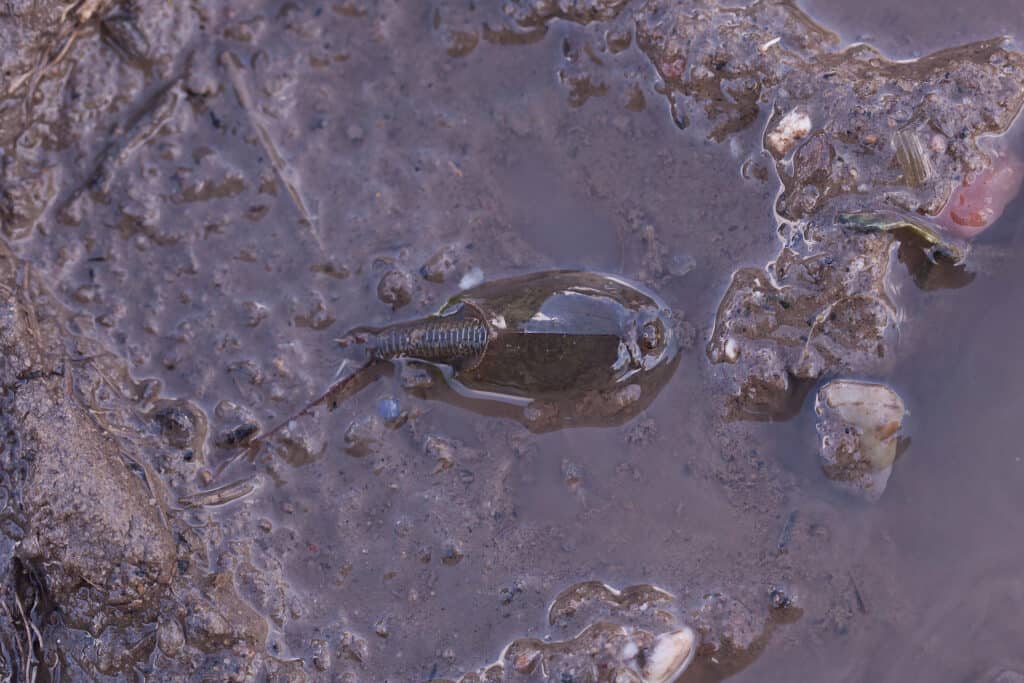Dinosaur Shrimp
T. longicaudatus
These "shrimp" evolved to survive very harsh climates, which is one reason they have been able to live so long.
Advertisement
Dinosaur Shrimp Scientific Classification
- Kingdom
- Animalia
- Phylum
- Arthropoda
- Class
- Branchiopoda
- Order
- Notostraca
- Family
- Triopsidae
- Genus
- Triops
- Scientific Name
- T. longicaudatus
Read our Complete Guide to Classification of Animals.
Dinosaur Shrimp Conservation Status
Dinosaur Shrimp Facts
- Prey
- Insects, small fry, tadpoles, worms
- Group Behavior
- Solitary
- Group
- Fun Fact
- These "shrimp" evolved to survive very harsh climates, which is one reason they have been able to live so long.
- Other Name(s)
- Tripods, shield shrimp, tadpoles
- Optimum pH Level
- 6.3-7.8
- Incubation Period
- Varies
- Habitat
- Temporary pools of water
- Predators
- Frogs, Birds
- Diet
- Omnivore
- Special Features
- Ability to survive harsh environments
- Number Of Species
- 13
- Location
- Every continent except Antarctica
Dinosaur Shrimp Physical Characteristics
- Color
- Brown
- Dark Brown
- Pink
- Skin Type
- Smooth
- Lifespan
- 20-90 days
- Length
- Up to 1.6 inches
- Age of Sexual Maturity
- 2-3 weeks
- Venomous
- No
- Aggression
- Low
View all of the Dinosaur Shrimp images!
In order to hatch, Dinosaur Shrimp eggs must dehydrate and then be rehydrated.
The Dinosaur Shrimp, also commonly called the American tadpole shrimp or the longtail tadpole shrimp, is a freshwater crustacean that looks like a miniature horseshoe crab.
They are an ancient animal that hasn’t changed much since the Devonian period, about 419 million to 359 million years ago. They can be found in various areas throughout the world, including western North America and South America, Southeast Asia, and the Pacific Islands, including Japan.
5 Dinosaur Shrimp Facts
- Dinosaur Shrimp is a species that is very old and considered a living fossil. Their outer appearance has not changed since the time of the dinosaurs, over 300 million years ago.
- Dinosaur Shrimp have three eyes. Two eyes are regular compound eyes, and the third ocellus eye only detects light.
- The eggs have the capability of a process called diapause. They will dry out and can withstand extreme conditions for over 20 years. They will only hatch once they are exposed to water again.
- The lifespan of these shrimp is extremely short. They hatch, mature, and lay eggs in only eight days. They will then die once the water in the area where they live dries up, or within 90 days of hatching.
- Some Dinosaur Shrimp are hermaphrodites; they have both male and female organs. Others do not and are considered males and females. Even with this, the eggs that the females lay can hatch without being fertilized by the male.
Dinosaur Shrimp Classification and Scientific name
The scientific name for Dinosaur Shrimp is Triops longicaudatus. They are also sometimes called American tadpole shrimp, longtail tadpole shrimp, and summer tadpole shrimp. Triops is the Greek word for “three eyes.” This is in reference to the two main eyes that these shrimp have, and a third simple eye that only detects light.
Dinosaur Shrimp are in the order Notostraca. This order only contains one family, Triopsidae, and two genera, Triops and Lepidurus. Both of these genera are considered “living fossils,” in that they have existed since prehistoric times. The name “Dinosaur” references that the Dinosaur Shrimp has existed since the dinosaurs. The Triops Genus has 13 different species. At least one of these species is found on every continent in the world except for Antarctica.
Dinosaur Shrimp Appearance
Dinosaur Shrimp are actually not shrimp at all; they are a crustacean that resembles a small horseshoe crab. They are usually a dull yellow or brown in color. Their head has two compound eyes that are very close together and almost touching.
They also have a third eye called a “naupliar ocellus.” This is a simple eye that only detects light. The compound eyes are on the surface of the head, and the third eye is actually deep in the center of the head.
On the bottom side of the head, the shrimp has a very small mouth typical of most crustaceans.
This shrimp’s thorax is just behind the head. The front part (anterior) of the thorax contains eleven segments, with the rear part (posterior) of the thorax containing 16-25 segments. Each segment has a pair of legs, called pereiopods.
The legs in the anterior thorax are the best developed, with the others assisting as needed. The rest of the body is sometimes considered the abdomen, with 5-14 segments that do not have legs. The overall length of the Dinosaur Shrimp can reach 1.5 – 3 inches long.

Dinosaur shrimp can survive in shallow water. When the pond dries up, residual eggs can be rehydrated and hatched.
©Pavel Krasensky/Shutterstock.com
Dinosaur Shrimp Distribution, Population, and Habitat
Dinosaur Shrimp is a freshwater crustacean that inhabits much of Western North America, South America, Japan, South Korea, and several Pacific Islands. They typically inhabit shallow pools of freshwater (although can survive in low salinity water) that are temporary in nature.
In the dry season (summer and autumn) the pools dry up, and in the wet season (spring and winter) the pools fill. The Dinosaur Shrimp is only present during the wet season. They can live in water that may only last for a short time before drying out again. Since they have adapted to extreme conditions and have been in existence for such a long time, it is believed that the conservation status is not a concern.
Dinosaur Shrimp Predators and Prey
Dinosaur Shrimp will eat virtually any organic matter that they can fit in their mouth. They scavenge the pools they live in for floating organic material, zooplankton, and insect larvae.
They have been known to be a pest in rice fields, where they eat the young plants and make the water cloudy by stirring up the silt and dirt on the bottom. Cloudy water cuts down on the amount of light that reaches the plants underwater.
When other food is scarce, they have been known to eat each other.
What Eats Dinosaur Shrimp?
Predators of these shrimp include waterfowl, birds, and frogs.
What Do Dinosaur Shrimp Eat?
Dinosaur Shrimp eat zooplankton, insect larvae, algae, and organic debris.
Dinosaur Shrimp Reproduction and Lifespan
Some populations of Dinosaur Shrimp are hermaphrodites, which means they have both male and female organs. Others breed like typical males and females, with the females laying eggs and the males fertilizing them.
Unfertilized eggs can also produce young (Parthenogenesis) and this seems to be the most common strategy.
The female’s eleventh pair of legs are modified to have egg sacs, where the eggs are held for several hours. The eggs are released in batches in different areas. The eggs are very resilient and have a thick shell.
They are unique in that they have to dry out completely and then be exposed to water again in order to hatch. This process is called “diapause,” and is one of the reasons for the Dinosaur shrimp to be able to survive extinction from drought or harsh conditions. The eggs can lay dormant for 20-27 years, waiting for water to return so they can hatch.
Once the eggs hatch, the shrimp progress into adults very quickly.
Within 24 hours of hatching, they resemble a small adult. After eight days, they reach maturity and can lay eggs. Adult Dinosaur Shrimp will die once the water where they live dries up. If the water does not dry up, they will typically die 20-90 days later.
Due to their eggs being able to survive for years and their short lifespan, they can often appear in areas where they have not been seen for quite some time.
They are also a popular choice of pets for children since their eggs require no special treatment in storage or transport, their lifespan is short, and their diet is very general.
Dinosaur Shrimp In Fishing And Cooking
Dinosaur Shrimp are not shrimp at all and are not a good food source for humans. They resemble a small crab or even an insect more so than a shrimp.
Similar Animals
View all 110 animals that start with DDinosaur Shrimp FAQs (Frequently Asked Questions)
Where are Dinosaur Shrimp found?
Dinosaur Shrimp are found in shallow freshwater pools that are temporary and dry up periodically. They can be found in Western North America, South America, Japan, southeast Asia and some Pacific islands.
Thank you for reading! Have some feedback for us? Contact the AZ Animals editorial team.
Sources
- Wikipedia, Available here: https://en.wikipedia.org/wiki/Triops_longicaudatus
- Live Science, Available here: https://www.livescience.com/triops-dinosaur-shrimp
- (1970)

















